| South Pacific:
The Game
By Mike Bennighof, Ph.D.
December 2022
 Second World War at Sea has been around for a while now (over 20 years!) with a stable rules set that we re-wrote in 2018. Even with that core rulebook, it’s not strictly a matter of plugging in new scenarios when we create a new game. There’s still a lot of design work involved. Second World War at Sea has been around for a while now (over 20 years!) with a stable rules set that we re-wrote in 2018. Even with that core rulebook, it’s not strictly a matter of plugging in new scenarios when we create a new game. There’s still a lot of design work involved.
Second World War at Sea: South Pacific is the largest game in the series (we once published an even larger game, Leyte Gulf, but that one will never come back into print). South Pacific’s theme is one we’ve visited before: the pivotal naval campaign of the Pacific war, the battles for the Solomons. The United States Navy, still reeling from the losses at Pearl Harbor, the Coral Sea and Midway, threw the bulk of its Pacific Fleet into the narrow waters of The Slot, the channel running down the center of the Solomons, to protect the vulnerable beachhead and airfield on Guadalcanal. The Japanese countered by sending the cream of their fleet, the well-drilled cruiser and destroyer forces, into the same narrow waters to isolate and destroy the Marines hanging on to Guadalcanal. Both navies were well-drilled, well-led, and determined. And the Americans ultimately won.
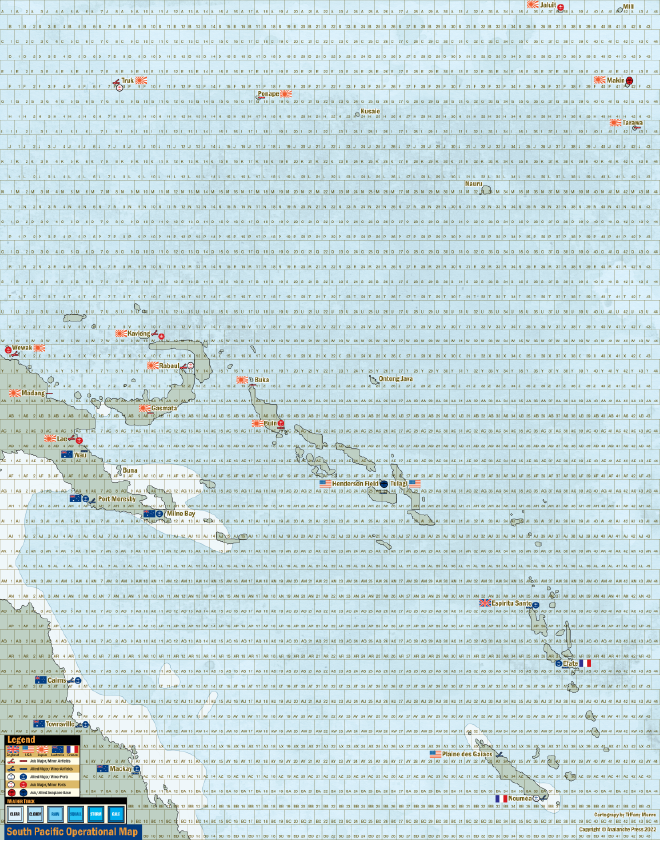 The design task is to tell that story within that standard rulebook. The easy way out is to just write an extra rule for every event, technology or individual impacting the story. But these games need to be played by humans, not just looked at and put on the shelf. So the standard rules need to work for every situation, as much as possible, without additional special rules. The design task is to tell that story within that standard rulebook. The easy way out is to just write an extra rule for every event, technology or individual impacting the story. But these games need to be played by humans, not just looked at and put on the shelf. So the standard rules need to work for every situation, as much as possible, without additional special rules.
I ended up writing more of South Pacific than I had expected. History is a story, and I want our games to tell that story, whatever it might be. Telling stories in game format is something I love to do, and the South Pacific is filled with stories (just ask Michener). The Solomons campaign really is the turning point of the Pacific theater: it’s the final place where the Imperial Japanese Navy had a realistic chance to influence the war’s outcome with a victory. And the campaign is really interesting in itself, with just about every type of naval action that can be imagined. There are battleships in action against each other, not something that happened often in World War II. Fierce night actions between cruiser-destroyer squadrons. Carrier battles. Supply runs. Submarine attacks. The Solomons have it all.
South Pacific isn’t like other Second World War at Sea games. Back at the turn of the century we published a much smaller game than South Pacific set in the same campaign. That was the first Second World War at Sea game, and we’ve learned a great deal since then. It laid down the pattern of every game in the series since: task forces move on an operational map showing the region where the campaign took place. When they meet, play moves to a generic blue Tactical Map, where they can fight each other with guns and torpedoes.
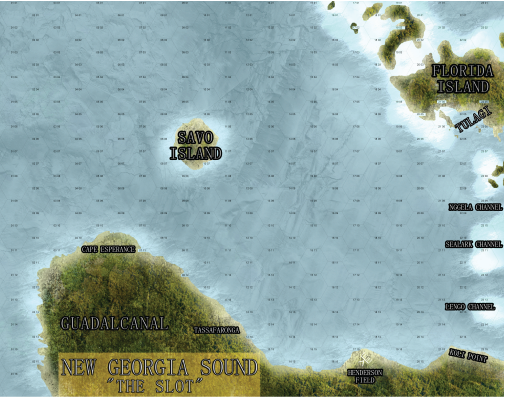 South Pacific has that map, too (though it’s evolved a lot since then). But it also sports something we’ve never tried before: a unique Tactical Map covering the place where so much of the tactical fighting took place, Ironbottom Sound. Both sides needed to run their reinforcement convoys into this narrow patch of water, which made contact almost inevitable. Even when actual surface battles didn’t break out, the chance of such a clash remained high, and it was by far the highest in Ironbottom Sound. South Pacific has that map, too (though it’s evolved a lot since then). But it also sports something we’ve never tried before: a unique Tactical Map covering the place where so much of the tactical fighting took place, Ironbottom Sound. Both sides needed to run their reinforcement convoys into this narrow patch of water, which made contact almost inevitable. Even when actual surface battles didn’t break out, the chance of such a clash remained high, and it was by far the highest in Ironbottom Sound.
That Ironbottom Sound map sees lots of time on the game table, with plenty of battle scenarios taking place on it plus those battles that arise from operational scenarios. It’s pretty much a complete game on its own, except, it’s part of a larger operational game, too. Robin Rathbun and Jim Stear wrote most of the rules for play on the Ironbottom Sound map, but I added or re-wrote some.
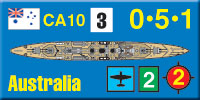 Time moves more slowly in Ironbottom Sound. A battle lasts for many more rounds than in the standard game on the standard Naval Tactical Map, but there are some adjustments to combat to even that out and it works very nicely. You get to steam leisurely past all the highlights: Tulagi, Savo, Lunga Point, Tassafaronga. Time moves more slowly in Ironbottom Sound. A battle lasts for many more rounds than in the standard game on the standard Naval Tactical Map, but there are some adjustments to combat to even that out and it works very nicely. You get to steam leisurely past all the highlights: Tulagi, Savo, Lunga Point, Tassafaronga.
Thanks to all the airplanes overhead, combat on the Ironbottom Sound map almost always takes place at night. That brings radar into the picture. Radar played no part in the old game we did on this campaign, and it doesn’t play much of a role in any other Second World War at Sea game.
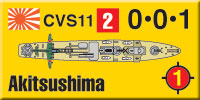 I stripped down the proposed radar rules, and made them optional. With just a couple of exceptions only American ships have it, by type and date (all battleships, all heavy cruisers etc.). I didn’t want players having to look stuff up in the middle of play, which is annoying, and I didn’t want them to have to pinpoint which ship has which radar when. There are just two types, search and fire control, and their effects are relatively minor (ships that have them spot a little better at night, or shoot a little better, or usually both). I stripped down the proposed radar rules, and made them optional. With just a couple of exceptions only American ships have it, by type and date (all battleships, all heavy cruisers etc.). I didn’t want players having to look stuff up in the middle of play, which is annoying, and I didn’t want them to have to pinpoint which ship has which radar when. There are just two types, search and fire control, and their effects are relatively minor (ships that have them spot a little better at night, or shoot a little better, or usually both).
The surface ships entered the fray in large part because the aircraft carriers had inflicted such punishment on one another in the carrier battles (or submarines had caught up with them). There are two major carrier battles in South Pacific, plus several others that probably should have broken out but did not (when search planes failed to find the enemy – which can happen in the “historical” battles, too).
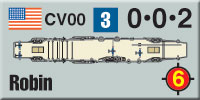 Yet despite the different types of battle and forces, the mission remained remarkably consistent throughout the campaign: to run supply and reinforcement convoys to Guadalcanal (from Rabaul or Buin for the Japanese, from Espiritu Santo or Nouméa for the Americans) and stop the other guy from getting through. More often than not, both sides are trying to accomplish both of these objectives at the same time. Yet despite the different types of battle and forces, the mission remained remarkably consistent throughout the campaign: to run supply and reinforcement convoys to Guadalcanal (from Rabaul or Buin for the Japanese, from Espiritu Santo or Nouméa for the Americans) and stop the other guy from getting through. More often than not, both sides are trying to accomplish both of these objectives at the same time.
All of it adds up to the best game package we’ve ever put together, from the physical quality of the components to the history packed into the scenarios to the fun game play. This is the game you need on your table.
You can order South Pacific right here.
Sign up for our newsletter right here. Your info will never be sold or transferred; we'll just use it to update you on new games and new offers.
Mike Bennighof is president of Avalanche Press and holds a doctorate in history from Emory University. A Fulbright Scholar and NASA Journalist in Space finalist, he has published a great many books, games and articles on historical subjects; people are saying that some of them are actually good.
He lives in Birmingham, Alabama with his wife and three children.
Want to keep Daily Content free of third-party ads? You can send us some love (and cash) through this link right here.
|
